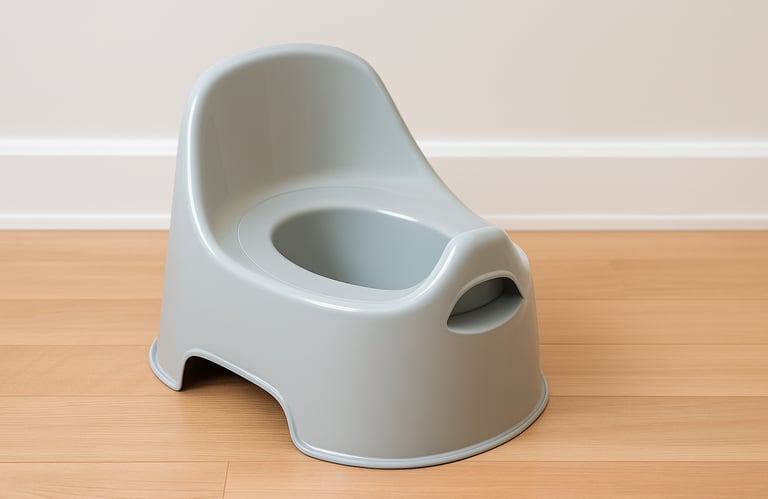Potty Training Made Simple: A Mom’s Step-by-Step Guide
3 min read


Introduction
Potty training is one of those milestones every mom both looks forward to and dreads at the same time. On one hand, it means no more diapers, less mess, and a big step toward independence for your little one. On the other hand, it can feel overwhelming, frustrating, and even discouraging when things don’t go as planned. The truth is, potty training doesn’t have to be complicated. With patience, the right approach, and a little encouragement, your child will get there.
This guide will walk you through the process step by step, making it easier to stay consistent and calm while helping your child succeed.
Step 1: Know When Your Child Is Ready
The biggest mistake many parents make is rushing potty training before their child is ready. Readiness is key.
Some signs your little one may be ready include:
Staying dry for longer periods (2+ hours).
Showing curiosity about the toilet or wanting to imitate others.
Communicating when their diaper is wet or dirty.
Pulling off diapers or asking to be changed.
Demonstrating the ability to follow simple instructions.
Most children show readiness between 18 months and 3 years old, but every child is different. Moms—don’t compare your child to others; follow their cues.
Step 2: Gather Your Tools
Before starting, make sure you have the right supplies.
These will make the process smoother:
A potty chair or seat insert: Many kids like their own small potty, while others prefer a seat that attaches to the regular toilet.
Training underwear or pull-ups: These make it easier to transition away from diapers.
Step stool: Helps with climbing up to the toilet and washing hands afterward.
Fun incentives: Stickers, small treats, or even a potty training chart can be great motivators.
Plenty of patience: This one’s free, but it’s the most important!
Step 3: Introduce the Idea
Start by casually introducing the potty to your child. Let them sit on it fully clothed at first so they can get comfortable. You can even let them decorate their potty chair with stickers or place it in a spot where they spend time.
Modeling also helps—children love to copy their moms. You can say something like: “Mommy uses the potty too. One day, you will too!” Simple, encouraging language works wonders.
Step 4: Create a Routine
Children thrive on routine. Set regular times throughout the day to sit your child on the potty, such as:
First thing in the morning.
After meals.
Before nap time and bedtime.
Anytime they show signs of needing to go (wiggling, squatting, holding themselves).
Even if they don’t go, the consistency helps build the habit.
Step 5: Encourage, Don’t Pressure
This step is where moms often feel the most stress—but remember, pressure backfires. Celebrate small successes with clapping, high fives, or praise like “You’re doing such a great job trying!”. If your child has an accident, stay calm and simply say: “That’s okay, we’ll try again next time.”
Positive reinforcement builds confidence; pressure or frustration creates resistance.
Step 6: Handle Accidents Gracefully
Accidents are a normal (and necessary) part of potty training. The key is to stay patient and keep perspective. Instead of scolding, use it as a teaching moment: “Oops, we didn’t make it to the potty this time. Let’s clean up and try again.”
It helps to keep extra clothes on hand, especially when you’re out and about. A waterproof mattress protector can also save you during nighttime training.
Step 7: Transition to Underwear
Once your child starts using the potty consistently during the day, make the switch to underwear. This step feels like a big deal for kids—it signals they’re “grown up.” Let them pick out fun designs or colors.
Some moms find pull-ups useful at night until their child wakes up consistently dry. That’s completely fine—night training can take longer.
Step 8: Expect Setbacks
Even after a child is trained, regressions can happen—during times of stress, change (like starting preschool), or excitement. If setbacks happen, don’t panic. Just go back to basics, keep encouraging, and know that it’s temporary.
Step 9: Celebrate Success
When your child masters potty training, celebrate!
You can:
Have a “big kid” party with a favorite treat.
Give them a special reward, like a new toy or outing.
Simply shower them with love and pride.
The key is to recognize their accomplishment—it makes them feel confident and proud.
Extra Mom Tips
Stay consistent: If multiple caregivers are involved, make sure everyone follows the same routine.
Dress for success: Avoid complicated clothing that makes it hard to undress quickly.
Read potty books together: Stories with characters learning to use the potty can make the process relatable.
Keep your sense of humor: Some funny moments will happen—laugh when you can.
Final Thought
Potty training isn’t about perfection—it’s about progress. Every child learns at their own pace, and as moms, our job is to guide them gently, not force them. With patience, encouragement, and consistency, you’ll help your little one achieve this milestone while building their confidence along the way.
So, take a deep breath, grab your potty supplies, and remember: you’ve got this, Mama!
Real support from real parents.
Real answers. No ads. No judgment.
Just calm support from real parents.
Follow Mommy Sloth on Pinterest
Mommy Sloth shares lived parenting experience, not medical or clinical advice.
Always consult your pediatrician or licensed professional when you’re unsure.
© 2025. All rights reserved.
